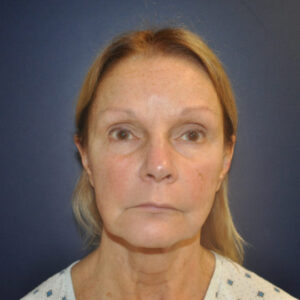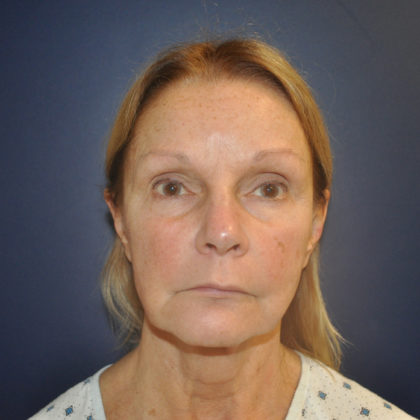Offered at our convenient location in Raleigh, NC
A facelift – also known as a rhytidectomy – is a cosmetic surgery that restores a more youthful appearance to the face and neck. This surgery is a reliable option when less invasive procedures, such as cosmetic injections, fail to deliver adequate results.
Here at Allen Aesthetic Surgery, Dr. Amber L. Allen performs expert facelift procedures that can seriously enhance the appearance of her patients. She dedicates herself to giving every patient thoughtful and personalized care. For more information, call (919) 676-5052 or contact us online to book a personal consultation.
Contents

Before and After Photos


About Facelifts
Facelifts are among the top five cosmetic surgeries performed in the United States each year. More than 100,000 take place in America annually – the majority of which are performed on women. In fact, 9 out of every 10 facelifts are performed on females, most of whom are over the age of 40.
Facelifts involve a surgeon making incisions in discrete locations around the face in order to remove excess skin, fat, and tissue. They selectively remove and redistribute fat and lift underlying muscle and tissue. They close the incisions with the skin positioned in a tighter, lifted position. (1)
Though facelift procedures cannot stop the aging process, they can take many years off the face – especially when paired with brow lifts or eyelid surgery, which help lift and rejuvenate the eyes and brow line.
Mini Facelift
Here at Allen Aesthetic Surgery, we offer mini facelifts as a less-intensive alternative to the facelift procedure. Mini facelifts are designed to treat the lower half of the face. They involve a surgeon making comparatively smaller incisions to reduce jowling and softening of the nasolabial folds. This procedure is a great option for patients who do not need significant enhancement and prefer to undergo a simpler procedure that will leave less noticeable scars.
Another procedure offered involves teeny incisions, Renuvion skin tightening in the lower face (and neck if desired) along with a suture to aid in “lifting the lower face” to provide a more youthful appearance. This procedure offers less downtime for those with a busy lifestyle.
Benefits of Facelifts
As you grow older, your skin and ligaments grow weaker and weaker. With the passing of time and the effects of gravity, this can cause sagging and wrinkling. Jowls can begin to form, as well as double chins and “turkey necks”. (2) Cosmetic treatments like facelifts can offset these unfortunate effects and give us a renewed sense of youth and beauty. The symptoms of aging that facelifts can address include:
- Lax and sagging skin
- Fine lines and wrinkles
- Nasolabial lines (lines between the nose and the corners of the mouth)
- Drooping fat that has lost its structural support
- Jowling of the cheeks at or below the jawline
- Double chin and “turkey neck”
Who is a Candidate for a Facelift?
An ideal candidate for the facelift procedure will want to combat the effects that aging has had on their appearance. They will want to take back control of their beauty and change their life for the better. If this sounds like you, then a facelift at Allen Aesthetic Surgery might be the right option!
If you want to receive a facelift, you should be in good health. Surgery can be an intense and energy-consuming experience for the body, and you need to be able to heal properly in order to appreciate the results of your treatment. You should also have realistic expectations about what a facelift can do for you. There are ways to naturally slow down the process of aging, like a healthy diet and lifestyle, that can optimize your results.
Personal Consultation
At your consultation, we can provide you with everything you need to know about our facelift procedure. We will ask you some questions about your medical history and run some tests to determine your current condition. We take the health of our patients seriously, so we want to make sure that the facelift procedure is a safe option for you. We will examine the condition of your face and ask you about your beauty goals. With the information we gather, we can devise a personalized treatment plan that brings you as close as possible to your ideal appearance. After discussing the details, we can schedule an appointment for your treatment and let you know what to expect moving forward. To schedule your personal consultation at Allen Aesthetic Surgery, call (919) 676-5052 or fill out this form.
Preparation
Dr. Allen will give you specific instructions on how to best prepare for your facelift procedure. We may give you particular medications or topical products to prepare your skin for treatment. We will base these instructions on your medical history and the results of the tests we run, so you should follow them carefully.
In general, you should avoid blood-thinning medications, as these can cause bleeding during surgery. If you are a smoker, you should quit for some time before and after your treatment, as the side effects of smoking can lead to complications during surgery and affect your ability to heal. Ask a friend to give you a ride to and from the facility on the day of your procedure, as the surgery and the anesthesia will leave you disoriented. If you can arrange it, you should have someone look after you for your first night of recovery.
Facelift Procedure
At Allen Aesthetic Surgery, we typically perform facelifts as outpatient procedures, which means you can go home the same day as your treatment. When you arrive at our facilities, we will give you either IV sedation or general anesthesia. Select patients are able to have a procedure with oral sedation and local anesthesia. All of these options will be discussed in order to offer which is best for you and your personal needs. To begin, Dr. Allen will make an incision along the crease where your ear meets your face. Depending on the extent of your procedure, your incision may also extend upward or downward along the hairline. She will thin-sculpt and redistribute fat within your face, neck, and along the jowl. She will then trim away excess skin and the underlying muscles and tissues will be lifted to form a more youthful appearance. We will wrap your treatment area for recovery. When the procedure is complete, we will move you to a recovery room and monitor you as your sedation or anesthesia wears off.
Recovery
Recovery from the facelift procedure typically takes several weeks, during which time it is normal to experience soreness and swelling. This can last for two to three weeks or more. Most patients are able to return to normal activity after just a few days. Downtime from work typically lasts a full week, though some patients who undergo more intensive facelift surgeries may take more time off. Be sure to take all prescribed medications, both for healing and for discomfort. We will give you instructions on how to take care of your incisions and what to watch out for as you recover. We ask that you follow up with us periodically to ensure that healing is progressing as anticipated.
Results
Because facelift surgery heavily affects the appearance of the face as the incisions heal, some patients are wary of presenting themselves to the public at first. Most patients find that their faces are presentable about two weeks after their procedure. It will take several more weeks, or even months, for swelling to go down completely and reveal the full results of the facelift.
Your face will be renewed, revitalized, and more youthful. However, as with any cosmetic surgery, results may vary. It is common to receive additional treatments to maintain the results of a facelift after the inevitable effects of aging and gravity have affected your appearance once more.
Corresponding & Complementary Procedures
We offer procedures that can improve upon or work alongside your facelift.
Forehead Lift
A forehead lift can address heavy, overhanging eyebrows that cause excess pressure on the upper eyelids. It can also treat wrinkles on the forehead and correct uneven eyebrows. It is a cosmetic surgery that involves a surgeon making incisions on top of the forehead, near the hairline, in order to remove excess skin and lift and tighten the forehead. Forehead lifts are commonly performed alongside facelifts.
Eyelid Surgery
Eyelid surgery, also known as blepharoplasty, is a cosmetic surgery that can treat excess and sagging skin on the upper and lower eyelids. It can also treat the tired look caused by weak and drooping skin on the lower eyelids. This treatment can help to improve eyesight that can be blocked by excessively sagging upper eyelids. It involves making incisions on the eyelids to remove excess skin, fat, and tissue in order to tighten them up. Eyelid surgery is often paired with facelifts during a single surgery.
To see the other procedures available at Allen Aesthetic Surgery, check out our blog.
How Much Do Facelifts Cost in Raleigh?
To find out how much facelifts cost at Allen Aesthetic Surgery, call (919) 676-5052 or visit our contact page.
FAQ
You may be a candidate for a facelift if you are a healthy non-smoker who is bothered by changes to your facial muscle tone or skin. A facelift could make you look younger and more beautiful if you have sagging skin, wrinkles, fine lines, jowling, or a double chin.
Facelifts do technically leave visible scars, though a skilled surgeon like Dr. Allen will do their very best to hide them. She makes incisions in discrete locations like behind the ear, in the fold of the jaw, and near the hairline.
Facelifts last for a long time- typically around ten years. However, the effects of aging and gravity on the skin and appearance are inevitable. Eventually, your face may begin to resemble its pre-facelift look. But there are many treatments that can maintain the results, and you can always receive additional facelifts down the road.
References
- Yang AJ, Hohman MH. Rhytidectomy. PubMed. Published 2021. https://www.ncbi.nlm.nih.gov/books/NBK564338/
- Barrett DM, Casanueva FJ, Wang TD. Evolution of the rhytidectomy. World Journal of Otorhinolaryngology – Head and Neck Surgery. 2016;2(1):38-44. doi:https://doi.org/10.1016/j.wjorl.2015.12.001
*RESULTS MAY VARY

